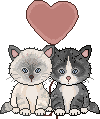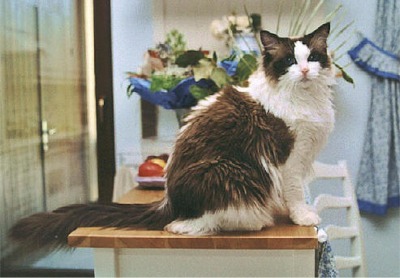
|
|
|
|

Seal Bicolour, Queenie de Cyanara 2001 (geb. 1993)
|
Vor etwa 35 Jahren, als
die Rasse Ragdoll entstand, war die Kombination von Colourpointfaktor,
Bicolourscheckung und Halblanghaarigkeit etwas ganz Neues. Die Bicolour Ragdoll
hatte es daher mit der Anerkennung bei den verschiedenen Katzenvereinen
von allen drei Varietäten am leichtesten. Die Colourpoint Ragdoll hätte
man mit früher gezüchteten Colourpointpersern verwechseln können, die
Mitted Ragdoll hatte damit zu kämpfen, sich von der Heiligen Birma
abzugrenzen.
Die Bicolour Ragdoll
aber war einmalig. Die koketten Handschuhe und Stiefelchen der
Mittedversion haben sich zu langen Abendhandschuhen und hüfthohen
Stiefeln vergrößert. Das Weiß reicht bis in die Maske hinein und bildet dort
ein möglichst regelmäßiges weißes "V", das der Bicolour Ragdoll den
typischen Ausdruck verleiht.
Die Bicolour mit ihrem
typischen, verkehrten "V" im Gesicht war für mich persönlich der
Einstieg in die Rasse Ragdoll und darüberhinaus lange "die" Ragdoll
schlechthin.
Some 35 years ago, when Ann Baker started to work on the breed, the combination of colourpoint factor, bicolour spotting and semilong hair was entirely new. Therefore the Bicolour Ragdoll was the first of the three Ragdoll varieties to be acknowledged in FIFe (1992). Initially the board of judges in charge of evaluating the Colourpoints and the Mitteds for acknowledment objected to give them Championship status due to their similarity to Colourpoint Persians, resp. Birmans.Colourpoints finally got the Championstatus in 1996, Mitteds in 1999. The Bicolour Ragdoll
was and is unique. The white on the front and hind legs extends up
to the body, also the belly should be white.The most significant feature
of the Bicolour Ragdoll is the inverted "V" that covers part of the mask.
|
|
Carpe Diem Cowboy Jim, Blue Bicolour |
Die dunklen Beine
sollten vollständig vom Weiß überdeckt sein, das "V" trennt die Maske
praktisch in zwei Teile. Dass die Bicolour Ragdoll auch eine
Colourpointkatze ist, erkennt man an den dunklen Ohren und am Schwanz. Das Ausstellen mit gut gezeichneten Bicolours macht immer noch etwas mehr Spaß als das Ausstellen mit Mitteds und Colourpoints, denn auch die Richter lassen sich meiner Erfahrung nach von der besonderen Ausstrahlung einer Bicolour Ragdoll beeindrucken.
|
|
Legs should be entirely white, the inverted "V" separates the mask. But also the Bicolour Ragdoll is a colourpointed cat - ears and tail show point colour. The Bicolour Ragdoll is the variety with the highest amount of white. Some Bicolours have a small "V" and no patches of white on the back, whereas others rather big "V"s and only little colour on the back. Breeding a perfectly marked Bicolour is one of the highlights in a breeder´s life. Showing Bicolours is more fun than showing the other varieties. For some reason the judges prefer the bicolours. |


